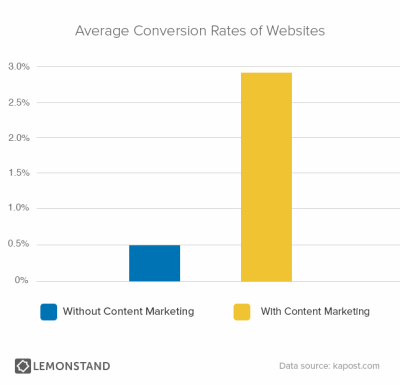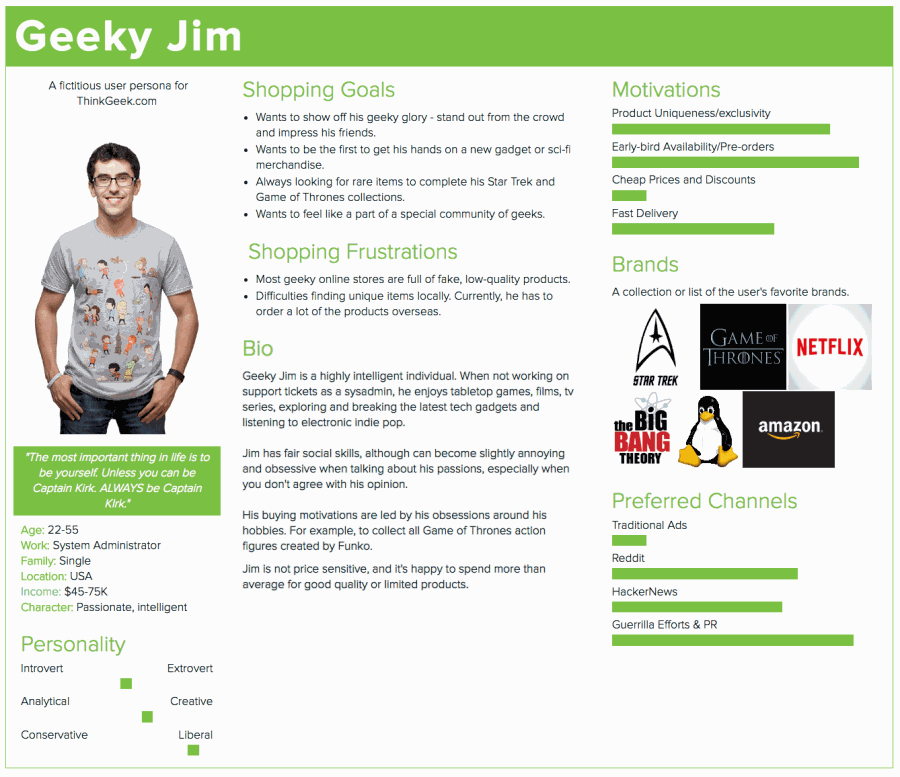How to Drive Sales with Your eCommerce Content Strategy
If I can go ahead and buy my stuff through Amazon, why would I bother to visit the brand site? Well, I wouldn’t unless I think that there is a valuable differentiator. Then, what does differentiate e-commerce websites? The answer is implementing an effective content strategy. Don’t believe me? Here are some statistics that will banish your doubts:
-
According to the experts at Demand Metric, content marketing costs 62% less than traditional marketing and generates approximately 3 times as many leads.
-
According to Forrester’s report, 72% of US online consumers prefer to use a company’s website to get answers to their questions, rather than contact them via telephone or email.
-
According to Gartner, 64% of people say customer experience is more important than price in their choice of a brand, and by 2020, customer experience will overtake price and product as the key brand differentiator. 
-
70% of consumers prefer getting to know a company via articles rather than ads.
-
The social media behavioral researcher, Tom Webster and the Edison Research team found that interesting content is a top 3 reason people follow brands.
-
82% of consumers have a more positive opinion about a company after reading custom content, and 70% feel a closer connection as a result of content marketing, based on the findings from Demand Metric’s research.
-
Lastly, according to kapost.com, the average conversion rate of sites with content marketing is 2.9%, compared to the average of sites without a content strategy, 0.5%. It basically means almost 6 times more conversion.
However, the common problem is not that online retailers do not realize the benefits of having a compelling content strategy. Although the majority knows that a solid content strategy will result in increased traffic, organic search rankings, brand awareness, conversion rates, and sales, many struggles to make it work on an e-commerce site. Now that we have covered the impact appealing content can have on your e-commerce business, let’s take a look at some of the ways you can improve your eCommerce content strategy:
Get to Know Your Audience
If you don’t want to throw a bunch of content against a wall and wait to see what sticks, you need to know your audience. To that point, you will want to create buyer personas which help you determine what type of content you will curate. Typically, one persona represents each group of target shoppers. Here is a good example of a persona that I found on ThinkGeek.com:

To know your audience, it is also important to differentiate two types of visitors: Shoppers and Buyers. Shoppers are the visitors who have already defined their problem but do not know the solution. Therefore, they browse away to find the right product that can solve their problem. Buyers, on the other hand, know what kind of product can solve their problems but they need to narrow down their options and ultimately make buying decisions.
As you can easily guess, shoppers need some education whereas buyers seek some free trials, demo, or case-studies to determine whether that product is what they search for.
Get Visual!
“If a picture is worth a thousand words, then a video is worth a million.” Either way visual content can go a  long way in terms of customer engagement. For example, according to the fifth annual UPS Pulse of the Online Shopper study, 70% of e-commerce site users rank the ability to zoom in on product images among their top priorities for deciding on a purchase. Not just product images work well, but also product videos that tell an engaging story can revolutionize any brand. A study by eyeviewdigital.com shows that using video on landing pages can increase conversion by 80%. Authenticity and thinking out of the box are the keys here though. For instance, in 2012, Michael Dubin launched an online men's razor merchant, Dollar Shave Club, with a hilarious YouTube video making fun of the pain and expense of shaving. The video went viral, the website crashed, and the blades sold out in six hours. Guess what? As a result, Dollar Shave Club hit the jackpot as Unilever agreed to buy the online men's razor merchant for $1 billion which is about five times the revenue that Dollar Shave Club is expected to bring in this year.
long way in terms of customer engagement. For example, according to the fifth annual UPS Pulse of the Online Shopper study, 70% of e-commerce site users rank the ability to zoom in on product images among their top priorities for deciding on a purchase. Not just product images work well, but also product videos that tell an engaging story can revolutionize any brand. A study by eyeviewdigital.com shows that using video on landing pages can increase conversion by 80%. Authenticity and thinking out of the box are the keys here though. For instance, in 2012, Michael Dubin launched an online men's razor merchant, Dollar Shave Club, with a hilarious YouTube video making fun of the pain and expense of shaving. The video went viral, the website crashed, and the blades sold out in six hours. Guess what? As a result, Dollar Shave Club hit the jackpot as Unilever agreed to buy the online men's razor merchant for $1 billion which is about five times the revenue that Dollar Shave Club is expected to bring in this year.
Since less competition is established for video content than a text article, if you add your video on YouTube and make it SEO-friendly, the video is 52 times more likely to show up on one of the Google search result pages. Also, do not limit yourself to only product videos, as how-to videos or guideline infographics make valuable and engaging pieces in many cases, too.
Another trick visual elements could do is breathing new life into old content. Why not brush up some older but evergreen content with some neat images?
Experience Drives Sales
Women now comprise 63% of all online buyers, according to Tiffany Bass Bukow, founder of MsMoney.com. “When shopping online, women look for a relationship in addition to convenience. Women enjoy websites where they can browse, chat, ask questions and feel a sense of community,” says Mark Levit, the founder and managing partner of Partners & Levit, Inc.
There are many ways to create an experience and a sense of community for your visitors. The FAQ page is  one of them. A study by Forrester discovered that as many as 72% of customers prefer to use self-help option rather than reach out to a company as modern customers tend to be self-researchers. So they will be searching your website for more information to get answers to their questions, long before they create contact with sales or a support department. Therefore, FAQ pages are a necessary piece of content. However, there is always a room for authenticity so try to go beyond a traditional FAQ page with some creative and niche ideas and design.
one of them. A study by Forrester discovered that as many as 72% of customers prefer to use self-help option rather than reach out to a company as modern customers tend to be self-researchers. So they will be searching your website for more information to get answers to their questions, long before they create contact with sales or a support department. Therefore, FAQ pages are a necessary piece of content. However, there is always a room for authenticity so try to go beyond a traditional FAQ page with some creative and niche ideas and design.
Chatbots are another great helper as this technology is designed to help businesses maintain the feeling of connection as well as eliminate wait times, dropped calls, and lost tempers. There’s been plenty of progress in getting chatbots up to speed in processing and responding to contextual awareness, thanks to big data and machine learning. "It's technology that's inevitable," Microsoft's CEO Satya Nadella has said and referred to the development of chatbots as a way to create “conversation as a platform.”
To create a sense of community user-generated content (UGC) is the key. As Leah Kinthaert pointed out in the 50th episode of the CMS-Connected Show: “Only 1% of millennials trust the products in ads”. Why? They see them as not authentic. Content created by a brand is still informative, but when it’s written by peers, that content is instantly considered more trustworthy. In fact, 63% of customers are more likely to make a purchase from a site which has user reviews. Check out the article entitled 4 B2B Content Marketing Trends You Need To Know for 2017 to find some UGC ideas along with real-world examples.
Product Description is Your Sales Pitch
Your production description should provide rich, informative but digestible information. Do not only list the features of your products but also mention the benefits so buyers can relate to their own issues. Including product reviews, ratings, customer testimonials, media endorsements, and number of products sold is a smart move, as people consistently seek approval from the community when they buy items. Explain what differentiates your product or your brand from the other without sounding overwhelmingly branded as it is a real turnoff for many. For SEO purposes, keep your product descriptions at a minimum of 250 words. Integrating the keywords where appropriate works great but avoid overstuffing them as search engines can view it as a black hat tactic, not to mention it dilutes the user experience.
Creating a solid e-commerce content strategy is the key to driving your sales goals. To me, the most important objective of your strategy should be building trust because that is what encourages people to purchase. When you spend a great deal of time providing valuable and tailored information, your brand will become a thought leader over time. It is okay if it takes time because building a long term sales pattern is always more valuable than viral results that won’t last. Therefore, your e-commerce content strategy will connect your brand with your audience from the earlier stages in the buying process. It is also crucial to build customer loyalty which is immersive for any business as it is 7 times more expensive to get a new customer than it is to retain an existing one.

Venus Tamturk
Venus is the Media Reporter for CMS-Connected, with one of her tasks to write thorough articles by creating the most up-to-date and engaging content using B2B digital marketing. She enjoys increasing brand equity and conversion through the strategic use of social media channels and integrated media marketing plans.